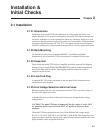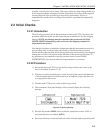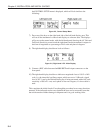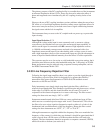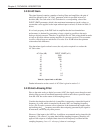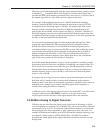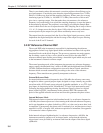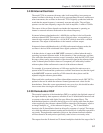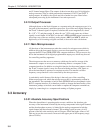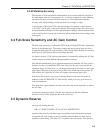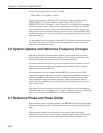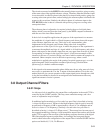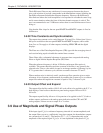
3-5
Chapter 3, TECHNICAL DESCRIPTION
This alias signal is indistinguishable from the output generated when a genuine signal
at frequency f
alias
is sampled. Hence if the frequency of the unwanted signal were
such that the alias signal frequency produced from it was close to, or equal to, that of
the wanted signal then it is clear that a spurious output would result.
For example, if the sampling frequency were 160 kHz then half the sampling
frequency would be 80 kHz. Let the instrument be measuring a signal of 55 kHz
accompanied by an interfering signal of 100 kHz. The output of the ADC would
therefore include a sampled-data sinusoid of 55 kHz (the required signal) and,
applying the above formula, an alias signal of 60 kHz (i.e. |100 kHz - 160 kHz|). If
the signal frequency were now increased towards 60 kHz then the output of the lock-
in amplifier would increasingly be affected by the presence of the alias signal and the
accuracy of the measurement would deteriorate.
To overcome this problem the signal is fed through the anti-aliasing filter, which
restricts the signal bandwidth. When operating at reference frequencies below
60 kHz, the reference frequency is less than half the sampling frequency and a
conventional elliptic-type, low-pass anti-alias filter is used. This enables the system
to provide the lowest possible noise bandwidth. At frequencies above 60 kHz an
adaptive bandpass anti-alias filter is used. The noise bandwidth of this filter is
dependent on the reference frequency and is higher than that of the conventional
type of filter, but typically the noise penalty is negligible.
It should be noted that the dynamic range of a lock-in amplifier is normally so high
that practical anti-alias filters are not capable of completely removing the effect of a
full-scale alias. For instance, even if the filter gives 100 dB attenuation, an alias at
the input limit and at the reference frequency will give a one percent output error
when the dynamic reserve is set to 60 dB, or a full-scale error when the dynamic
reserve is set to 100 dB.
In a typical low-level signal recovery situation, many unwanted inputs need to be
dealt with and it is normal practice to make small adjustments to the reference
frequency until a clear point on the frequency spectrum is reached. In this context an
unwanted alias is treated as just another interfering signal and its frequency is
avoided when setting the reference frequency.
A buffered version of the analog signal just prior to the main ADC is available at the
rear panel signal monitor (SIG MON) connector; it may be viewed on an
oscilloscope to monitor the effect of the signal channel filters and amplifiers.
3.2.06 Main Analog to Digital Converter
Following the anti-alias filter the signal passes to the main 18-bit analog to digital
converter running at a sampling rate of 166 kHz. This rate is not fixed but is adjusted
automatically by up to ±1 %, as a function of the reference frequency, to ensure that
the sampling process does not generate a “beat” frequency close to zero hertz. For
example, if the reference frequency were 82.95 kHz and the sampling frequency were
not adjusted, a beat frequency of 50 Hz (|82.95 kHz - (166 kHz/2)|) would be
generated and would appear at the output if the time constant were not set to a large
enough value.



